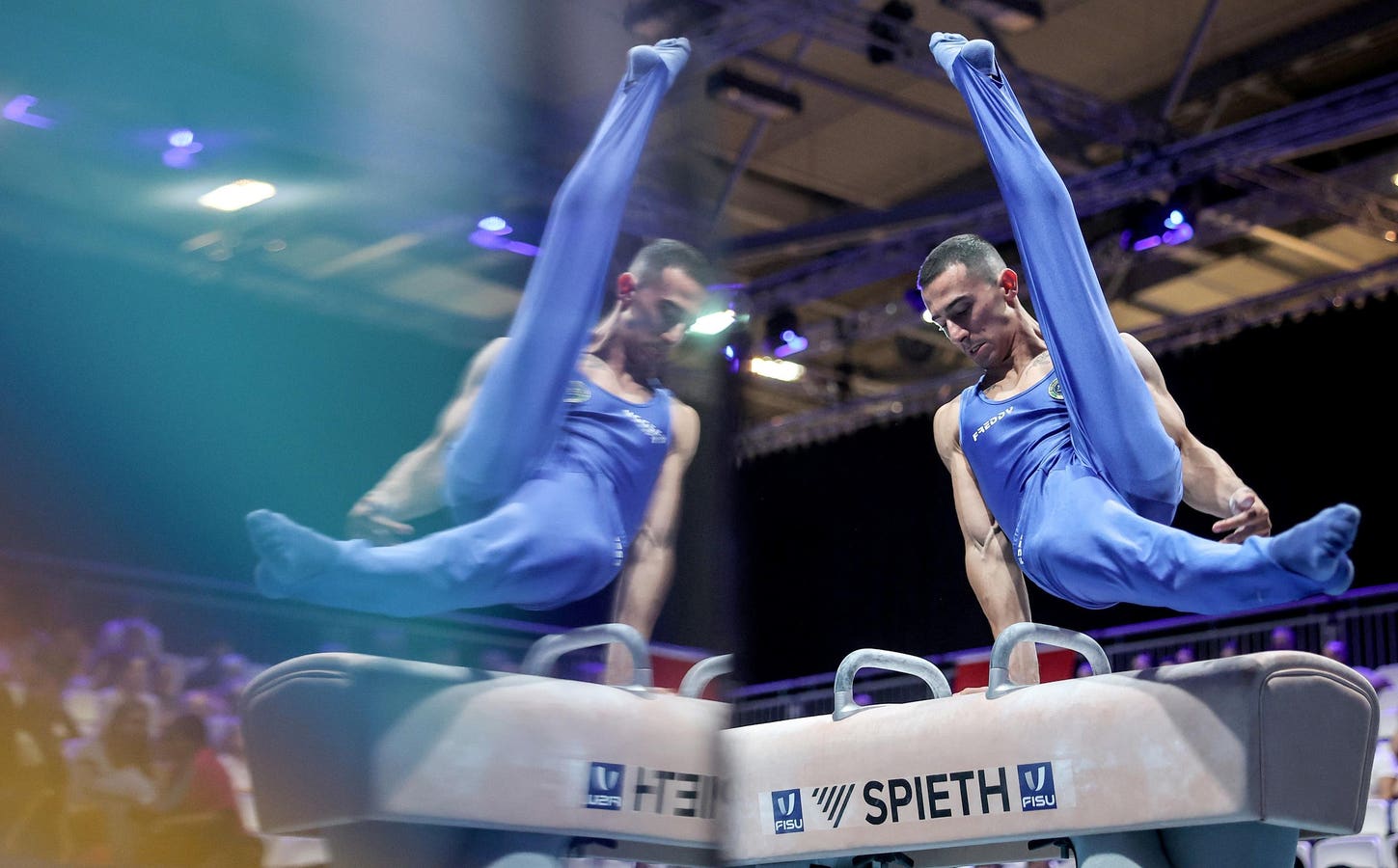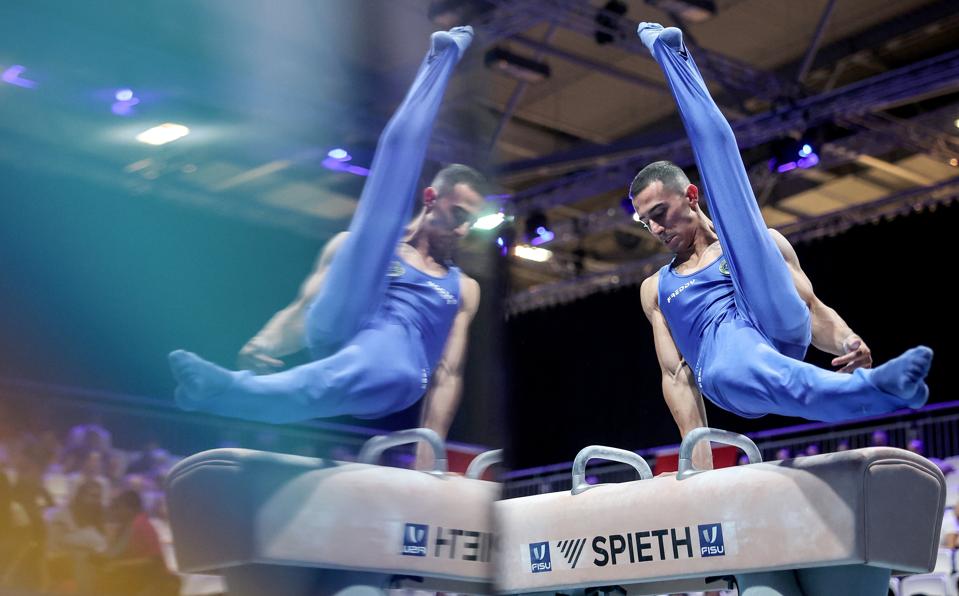ESSEN, GERMANY – JULY 23: Lorenzo Bonicelli of Italy competes on the Pommel Horse during the … More Artistic Gymnastics competition at day 8 of the FISU World University Games Rhine-Ruhr 2025 at Messe Essen on July 23, 2025 in Essen, Germany. (Photo by Lars Baron/Getty Images)
Getty Images
Italian men’s gymnast Lorenzo Bonicelli is in a medically induced coma after suffering a neck injury at the FISU Summer World University Games. Held in Germany’s Rhine-Ruhr region, the 2025 FISU Summer World University Games brought more than 8,500 student-athletes and officials to compete in 18 disciplines.
Bonicelli is just 23 years old and competes for the Ghislanzoni Gal gymnastics club located in Lecco, Italy, just north of Milan.
Like his national teammates, Bonicelli was likely aiming for selection to the Italian delegation that will compete at the 2025 World Championships in Jakarta, Indonesia.
When the injury occurred, Bonicelli and his teammates were competing in the Men’s Artistic Gymnastics team final and qualification round. The Italian team began the competition on floor exercise and then continued with a second rotation on pommel horse. In rotation three, disaster struck on the still rings.
Bonicelli competes one of the most difficult and risky dismounts in men’s still rings – a triple back. The dismount requires more than three complete rotations in order to land cleanly. On Wednesday, Bonicelli came up short, landing directly on his neck.
According to Ginnasticando Italia, medical workers present at the arena immediately rushed to Bonicelli’s side upon impact. The athlete was eventually carried out of the arena on a medical stretcher.
Due to the emotional distress inflicted by their teammate’s injury, the Italian team withdrew from competition following the third rotation.
On Thursday, July 24, an FIG official confirmed the severity of Bonicelli’s condition, sharing that the athlete had undergone near-immediate surgery on Wednesday.
Steve Butcher, the Apparatus Supervisor for men’s still rings, shared the following update on Bonicelli’s condition:
“Lorenzo (Bonicelli) is in a medically induced coma after surgery last night. It will take 10 or more days to know his condition. The entire gymnastics family is pulling for Lorenzo’s full recovery,” he added.
Severe Injury Risk in Gymnastics
Though neck and spinal injuries remain a palpable risk in men’s and women’s gymnastics, severe injuries – causing paralysis or death – are rare.
In 2019, a collegiate gymnast at Southern Connecticut State University died after “sustaining a spinal injury” during a routine training exercise on the uneven bars.
In 1988, American elite gymnast Julissa Gomez was paralyzed in a vaulting accident. She died in 1991 due to complications from her injuries.
Soviet star gymnast Elena Mukhina suffered a similar fate. Known for training the now-banned Thomas salto, Mukhina broke her neck two weeks before the opening of the 1980 Olympics, leaving her permanently quadriplegic.
Mukhina later revealed her concerns about competing the element in a 1991 documentary. “My injury could have been expected…it was inevitable. I had said more than once that I would break my neck doing that element,” she said.
Though she raised concerns to her coach, Mikhail Klimenko, Mukhina was dismissed. Klimenko said, “people like (her) don’t break their necks.” She died in 2006 at age 46.
“Gymnastics is a challenging sport that carries a substantial injury risk,” the American Journal of Emergency Medicine shared, adding that the sport’s head and neck injuries remain “under-studied.’”
In gymnastics, the most minor adjustment can make a significant difference.
The journal attested to the fine line between safety and tragedy in a 2023 study: “Epidemiology and patterns of gymnastics-related head & neck trauma injuries.” The study cited Simone Biles’ experience at the Tokyo Olympics as evidence of the risk.
Biles experienced “the twisties,” described as the “phenomenon of losing air space awareness while twisting,” the journal says. Though seemingly trivial in name, the phenomenon can “render a gymnast unable to land a twisting maneuver properly…as such, it is unsurprising that artistic gymnasts experience high rates of injury.”
“Twisties” or not, timing is essential in gymnastics. The journal shares a sobering finding: “the window for correct release parameters and successful dismount from the men’s high bar has been reported to be ∼73–84 milliseconds.”
That is, 0.073 to 0.085 seconds – a fraction of a second – can distinguish between a safe dismount and major injury.
Bonicelli’s diagnosis is still pending following his surgery, with Butcher attesting to a roughly 10-day wait to reveal the extent of his injuries. The broader gymnastics community has quickly wished him a speedy recovery and anxiously awaits an update.
Bonicelli’s Instagram bio reads: “Fight until the end.”

